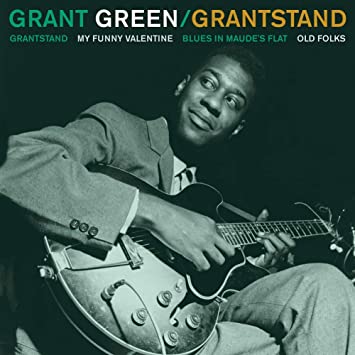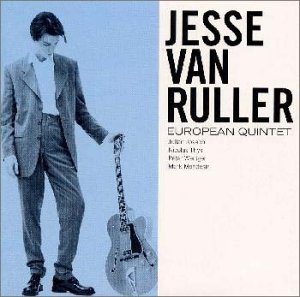Green's Greenery – Grant Green
This catchy, snappy blues head is classic Grant Green. Dutch guitarist Jesse Van Ruller recorded a remarkable reharmonized version in 1997; a melody part is available for this as well as a transcription of Jesse's solo.
- Recording: Grant Green - Grantstand
- Recorded on: August 1, 1961
- Label: Blue Note (CDP7-46430-2)
- Concert Key: B-flat
- Vocal Range: , to
- Style: Swing (medium)
- Tenor Sax - Yusef Lateef
- Guitar - Grant Green
- Organ - Jack McDuff
- Drums - Al Harewood
Video
- Description
- Historical Notes
- Solos
- Piano Corner
- Bass Corner
- Drum Corner
- Guitar Corner
- Inside & Beyond
- Minus You
A classic hard bop blues head from one of Grant Green's early Blue Note recordings, "Green's Greenery." The melody really tells a story within the space of only 12 measures: a rhythmic opening statement in the first four measures, another phrase developed for six measures, and a return to the initial rhythms in the last two. The head is played mostly with a 2-feel, broken up by some quarter notes; the organ bass notes are shown in our lead sheet in these places.
The recording begins with a chorus of organ walking bass and drums only before the head. Guitar and tenor sax play unison throughout the head.
The recording begins with a chorus of organ walking bass and drums only before the head. Guitar and tenor sax play unison throughout the head.
"Grantstand" was recorded at the legendary Van Gelder Studio in Englewood Cliffs.
While recorded at the session for Grant Green's third album as leader on Blue Note, "Grantstand" (1961), Green's Greenery was not publicly released until the album's CD reissue in 1987, likely because of its similarity to the 15-minute long Blues In Maude's Flat on the original release. Notably, this session is the only official recording of Yusef Lateef with Green, Al Harewood, or Jack McDuff. It's also one of only two studio recordings of Harewood and McDuff together—they would record again in 1993 for guitarist Joshua Breakstone's "Remembering Grant Green," which also includes a version of Green's Greenery and was recorded at Rudy Van Gelder's Englewood Cliffs studio.
While recorded at the session for Grant Green's third album as leader on Blue Note, "Grantstand" (1961), Green's Greenery was not publicly released until the album's CD reissue in 1987, likely because of its similarity to the 15-minute long Blues In Maude's Flat on the original release. Notably, this session is the only official recording of Yusef Lateef with Green, Al Harewood, or Jack McDuff. It's also one of only two studio recordings of Harewood and McDuff together—they would record again in 1993 for guitarist Joshua Breakstone's "Remembering Grant Green," which also includes a version of Green's Greenery and was recorded at Rudy Van Gelder's Englewood Cliffs studio.
With a catchy, riff-like melody, Green's Greenery is a delightfully bouncy B♭ blues that features inspired solo statements from Grant Green, tenor saxophonist Yusef Lateef, and organist Jack McDuff. Green solos first with his trademark blues-soaked style, incorporating some effective bebop vocabulary but first and foremost getting deep in the pocket and driving the band forward. Behind Lateef's soulful statement, Grant lays down some subtle and funky comping, locking in rhythmically with McDuff and Harewood while avoiding harmonic clashes with McDuff by using sparse voicings. Green's comping then widens up behind McDuff, incorporating a wider register and denser voicings in order to fill the primary comping role.
Guitarists of any level, though especially those who are at the beginner or intermediate level, will learn much through studying Green's groove, tastefulness, and situational awareness.
Guitarists of any level, though especially those who are at the beginner or intermediate level, will learn much through studying Green's groove, tastefulness, and situational awareness.
Related Songs
Email Send Green's Greenery to a friend
Send this page to a friend via email. Add your name or email in the first field. In the second, add one or more email addresses, separated by a comma.
- Recording: Jesse van Ruller - European Quintet
- Recorded on: January, 1997
- Label: Blue Music (BM 1002)
- Concert Key: B-flat
- Vocal Range: , to
- Style: Swing (medium)
- Soprano Sax - Peter Weniger
- Guitar - Jesse van Ruller
- Piano - Julian Joseph
- Bass - Nicolas Thys
- Drums - Mark Mondesir
Video
- Description
- Historical Notes
- Solos
- Piano Corner
- Bass Corner
- Drum Corner
- Guitar Corner
- Inside & Beyond
- Minus You
For this recording, Jesse Van Ruller completely reworked Green's Greenery, changing everything but the melody. The rhythm section doesn't play time on the head, instead complementing the melody with a series of hits. The reharmonized changes start on E7 and descend in half steps almost throughout. In the 11th measure, the meter changes to 6/4; this measure contains the last melody phrase, which now leads to a four-measure B section with a 6/4 Latin groove. This section is a vamp that alternates A♭7 and A7.
Our guitar melody part shows the piano top line in this section; the guitar plays chords along with the accented piano notes. A very clever, original arrangement.
Solos go back to swing for straight-ahead B♭ blues; the B section vamp is repeated and fades out after the out head.
The guitar part played by Jesse is available.
Our guitar melody part shows the piano top line in this section; the guitar plays chords along with the accented piano notes. A very clever, original arrangement.
Solos go back to swing for straight-ahead B♭ blues; the B section vamp is repeated and fades out after the out head.
The guitar part played by Jesse is available.
Dutch guitarist Jesse van Ruller exploded onto the scene in 1995, winning the Thelonious Monk Guitar Competition and recording alongside first-call musicians such as Tom Harrell, Billy Drummond and Christian McBride on vocalist Fleurine's 1995 album "Meant To Be," his first recording. "European Quintet" from 1997 was his debut album as a leader.
clip Jesse van Ruller's Transcribed Guitar Solo
One of the most fascinating aspects of Jesse Van Ruller's playing is his articulation style, which bestows an incredible amount of dynamic and rhythmic nuance onto every phrase that he plays. To attempt to capture these subtleties, our transcription contains two different note-head sizes and detailed slur markings.
Combined with Van Ruller's colorful harmonic and rhythmic imagination, this solo makes a great study for intermediate and advanced guitarists who want to improve their phrasing and get a glimpse into how a modern master approaches the blues.
One of the most fascinating aspects of Jesse Van Ruller's playing is his articulation style, which bestows an incredible amount of dynamic and rhythmic nuance onto every phrase that he plays. To attempt to capture these subtleties, our transcription contains two different note-head sizes and detailed slur markings.
Combined with Van Ruller's colorful harmonic and rhythmic imagination, this solo makes a great study for intermediate and advanced guitarists who want to improve their phrasing and get a glimpse into how a modern master approaches the blues.
While Jesse van Ruller's crisp and articulate sound, as well as his comfortable command of the blues language, reflect a clear understanding of Grant Green's style, his solo is quite different from Green's, with a greater emphasis on long eighth-note lines, harmonic ideas derived from the altered scale (7th mode of melodic minor), and triadic material. He also provides some tasteful, rhythmic comping behind Peter Weniger's soprano sax solo.
Related Songs
Email Send Green's Greenery to a friend
Send this page to a friend via email. Add your name or email in the first field. In the second, add one or more email addresses, separated by a comma.

Grant Green
June 6, 1935 – January 31, 1979
One of the most influential and important guitarists in jazz, Grant Green stood out for his exquisite melodic sense, deep rhythmic feel, and distinctive tone. Born into a musical household in St. Louis, Missouri, the guitarist grew up in a milieu of gospel and boogie-woogie. This early environment profoundly shaped Green's trajectory as a musician. Read more...
There was a problem.
...


